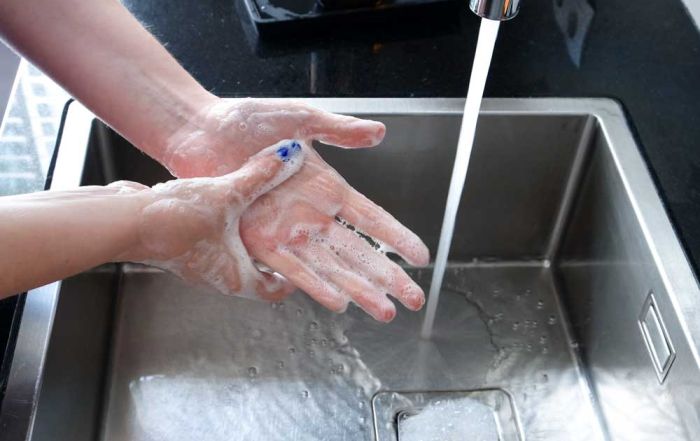Sanitation, Sanitation, Where Art Thou?
Continuing the theme I picked up on a few months ago, discussing common causes of foodborne illness, I’d like to focus this blog on cross contamination, more precisely sanitation. Sanitation is another issue that employees don’t often do at home, so they discount the importance of it in the food production environment. That is to say that they have never made someone sick at home because they only clean their countertops and they have likely never sanitized their kitchen, so why is it so important in a foodservice facility?
If you want to see how seriously your employees take sanitation, look no further than the first thing they do when they start production in the morning. Do employees start food production upon first arriving in the morning or do they take time to sanitize all the work surfaces before starting production? This may seem like an unnecessary step, especially in operations where there may only be one production shift, like in a school system. However, you can never really be too sure of what occurred during the evening when no one was using the space. Was a maintenance person working in the area with their work bag on the table? Did an after-hours delivery drive place boxes that were sitting outside on the ground on the preparation table? Did a rodent or cockroach (although we hate to think of this – it does happen) run across the table in the wee hours of the morning? Or perhaps the staff the day before didn’t really sanitize as well as they had thought they did.
If you want to see how seriously your employees take sanitation, look no further than the first thing they do when they start production in the morning…do they take time to sanitize all the work surfaces before starting production?
Often, our employees like to show off their clean kitchens, and certainly a clean kitchen is something to be proud of. Afterall, it cannot be sanitized if it is not first clean. However, we must be sure to educate our employees that we cannot stop at clean. We must be mindful to sanitize property and avoid cross contamination. A few years ago, we placed a camera in a school to watch sanitation practices and were surprised as what we found at the end of the day. We’ve released the video and use it in training to help employees understand the importance of cleaning vs. sanitizing and have made it available online free of charge.
Be certain your employees are also aware of the sanitizer you use in your facility –on surfaces and within the three-compartment sink and/or dishwasher. They need to know what product to use, but also the specifics about the product – how to mix it, proper strength, the amount of contact time for it to be effective, and how to properly utilize test strips to ensure that the concentration is correct.
Once you are sure your employees are knowledgeable about your sanitizers, the tricky part is ensuring that they use them when they are supposed to do so. This is again where that culture of food safety comes into play. As a manager, you cannot be everywhere all the time, so you must have a supportive environment where employees are able to remind other employees to properly sanitize surfaces or equipment when they see that it has not been done correctly. Allowing all employees to hold each other accountable in a supportive environment will go a long way to not only providing the safe food culture, but also ensuring guest satisfaction and safety throughout your organization.
Late last week, we released our second SafeBites Webinar of 2022. In the webinar, Dr. Ellen Shumaker, who directs the outreach and extension activities for the Safe Plates program at North Carolina State University, discusses food safety messaging and the role of food safety culture in shaping employee and organizational behaviors. This is the second release of our new on-demand webinar, please drop me a note and let me know if you enjoy the new format or not. Risk Nothing.
READ MORE POSTS
30 Years Later: The Foodborne Illness Outbreak that Changed Food Safety
In January, we hit a major anniversary. One I am betting snuck by many of you – including me! January marked 30 years since the deadly 1993 E. coli O157:H7 outbreak at Jack in the Box restaurants on the west coast. The anniversary wasn’t on any of the major news networks that I recall. It did make it into a few newspapers, at least one or two of the newspapers that are left. It wasn’t until late-February that I realized it.
Does Temperature Really Matter when Washing your Hands?
In January, I reviewed the changes to the 2022 Food Code in my blog (check out Part I and Part II), and one change to the food code that I had mentioned, but didn’t discuss in-depth, was the change that lowered the water temperature a hand sink was required to produce to 85°F, as noted in Section 2-202.12 of the code. This requirement has been in place since the publishing of the 2001 Food Code, which required a water temperature of 100°F. Prior to this, 110°F was required (see the 1999 Food Code). So why the change and does water temperature when washing your hands really matter?
Hand sinks: Often Taken for Granted, but an Essential Part to Effective Hand Hygiene
Late in January, I received a question about hand sinks in a foodservice operation. The question pertained to school staff (teachers and aides) who were using a hand washing sink in the school kitchen. The question came as a matter of who was allowed access to the kitchen to use the sink, but the question itself caused me to go down a rabbit hole of requirements for hand washing sinks in foodservice operations.
Hot off the Press: The 2022 Model Food Code has been Released! Part Two.
Earlier in the month, we started a discussion about the changes to the 2022 Food Code. If you missed that post, late in December 2022, the Food and Drug Administration released the 2022 Food Code and I wanted to highlight a few of the changes that have been made to the code.










